Is it our imagination, or…is spring finally just around the corner? After a winter that seemed longer, darker and colder than usual – without the warming distractions of cozy restaurant dinners, ski weekends or a festive family Christmas – we are all breathing a sigh of relief at the appearance of nesting songbirds and the daffodils and crocuses popping up in parks and gardens. To usher in the spring, we’re taking a stroll through some of our favourite natural landscapes courtesy of past sales (and one work currently available at Dickinson).
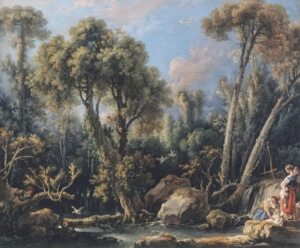

F. Boucher, Les Lavandières, 1760, sold by Dickinson to a private collector
François Boucher’s verdant landscape looks like an idyllic spot for a springtime stroll or picnic, with lush greenery surrounding a clear pool. The titular laundresses in Boucher’s painting Les Lavandières (1760), busy with their washing, have no time for picnics – although they do spare a moment for a coy glance at a young shepherd, observing them through the gnarled branches of an old tree. Boucher’s nature is untamed by civilisation, but it is also the setting for daily domestic activities and safe flirtations.
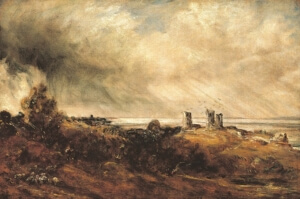

J. Constable, Hadleigh Castle: a distant view, 1828-29, sold by Dickinson to a private collector
Hadleigh Castle: a distant view (1828/29), by consummate British landscapist John Constable, shows us a slightly wilder side of nature, with ominous dark clouds gathering at the left of the canvas and sheets of rain streaming down on the Thames Estuary in the distance. A flock of birds directs the viewer’s attention to the ruined remains of Hadleigh Castle, built as a 13th century fortification. Having once dominated the landscape in which it stands, the castle was by Constable’s time a crumbling, picturesque ruin succumbing to the power of nature.
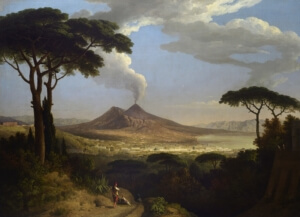

T. Jones, A view of the Bay of Naples from the Scudillo with travellers on a path, with the Royal Palace of Capodimonte and Mount Vesuvius erupting beyond, c. 1785, sold by Dickinson to an American museum
A very different type of nature features in Thomas Jones’s A view of the Bay of Naples from the Scudillo with travellers on a path, with the Royal Palace of Capodimonte and Mount Vesuvius erupting beyond (c. 1785). Jones, a Welsh artist who followed the British Grand Tourist community to Italy in search of patronage, offers a panoramic view of the Bay of Naples dwarfed by the iconic silhouette of Mt. Vesuvius – active, but spouting benign plumes of smoke rather than fire and ash into the sky. The elevated viewpoint and the inclusion of a small group of local peasants in the foreground, marked out against the landscape by their vivid red and yellow costumes, offers a sense of scale to Jones’s expansive coastal view.
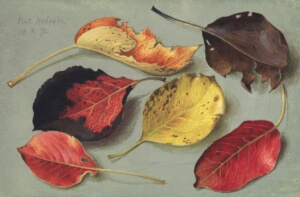

E. Hodgkin, Six Autumn Leaves, 1972, sold by Dickinson to a private collector
From the monumental to the miniscule: 20th century, English artist Eliot Hodgkin is known for his detailed, considered, almost Ruskin-esque studies of elements of the natural world, such as this painting of Six Autumn Leaves (1972). Hodgkin’s leaves, varied in colour, and painted in the autumn, are in no way remarkable, with their crumpled, torn edges and scattered insect holes. Hodgkin invites us to look more closely at these small aspects of the natural world that are typically overlooked – even trodden underfoot – by making them into something precise, jewel-like and very beautiful.
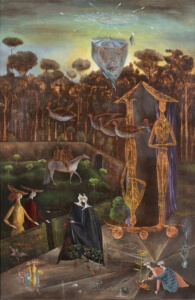

L. Carrington, Again the Gemini are in the Orchard, 1947, sold by Dickinson to Museum Boijmans Van Beuningen
If Hodgkin gives us the quotidian made significant, Leonora Carrington gives us nature made Surreal! Carrington’s painting Again the Gemini are in the Orchard (1947) combines elements from the fairy tales and legends the artist remembered from her childhood with European Surrealism and Mexican Mysticism. Carrington contrasts an orderly, enclosed garden, with its carefully pruned rows of identical shrubs, against a wilder jungle landscape beyond the garden wall, populated by strange creatures and birds.
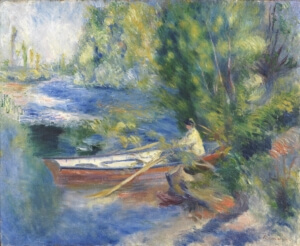

P.A. Renoir, Au Bord de l’Eau, 1885, sold by Dickinson to a private collector
To end, we can’t talk about nature in art without talking about the Impressionists – and here is Au Bord de l’Eau (1885) by Pierre-Auguste Renoir. Renoir explores a classic Impressionist plein air scene, of the type he had first developed while painting alongside Monet in the 1870s. A day in the country – boating, eating, walking, reading, or just sitting – was ideal as a source of material. Like his fellow Impressionists, Renoir was fascinated by changing effects of light and shadow, and he drew further inspiration from the bucolic landscapes of the French rococo. In this sunny view, Renoir’s tree-lined riverside inlet offers a view of nature at its most appealing and welcoming.
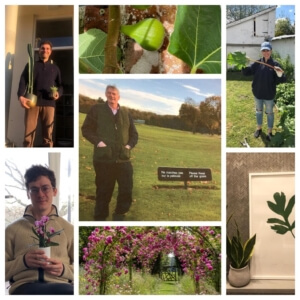

Wherever you choose to enjoy nature – whether in a forest, in a city park, in your garden or even in the plants lining your windowsill – there are plenty of inspiring artworks reminding you of its beauty and benefits. Team Dickinson is finding plenty of inspiration in our own gardens and local parks during lockdown; here are just a few examples of what we’ve been getting up to, from intrepid farming efforts, to carefully-tended houseplants, to Simon Dickinson’s masterpiece of a garden at home in Gloucestershire!


